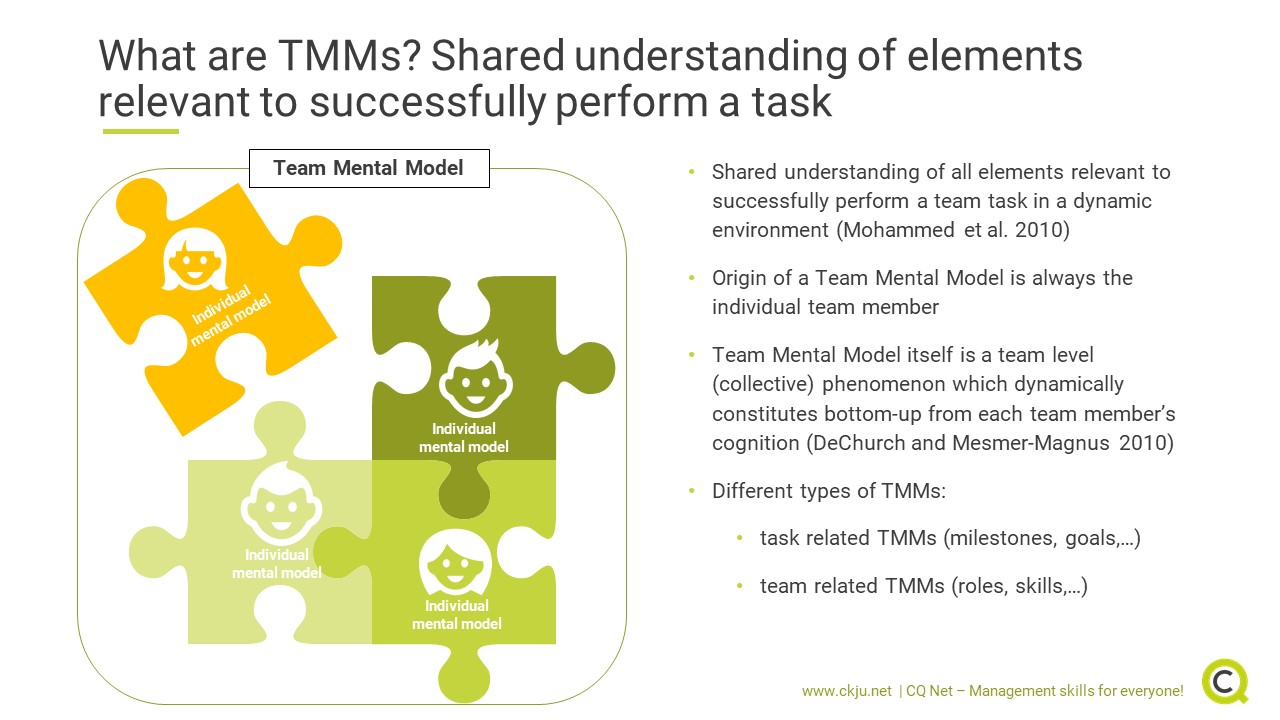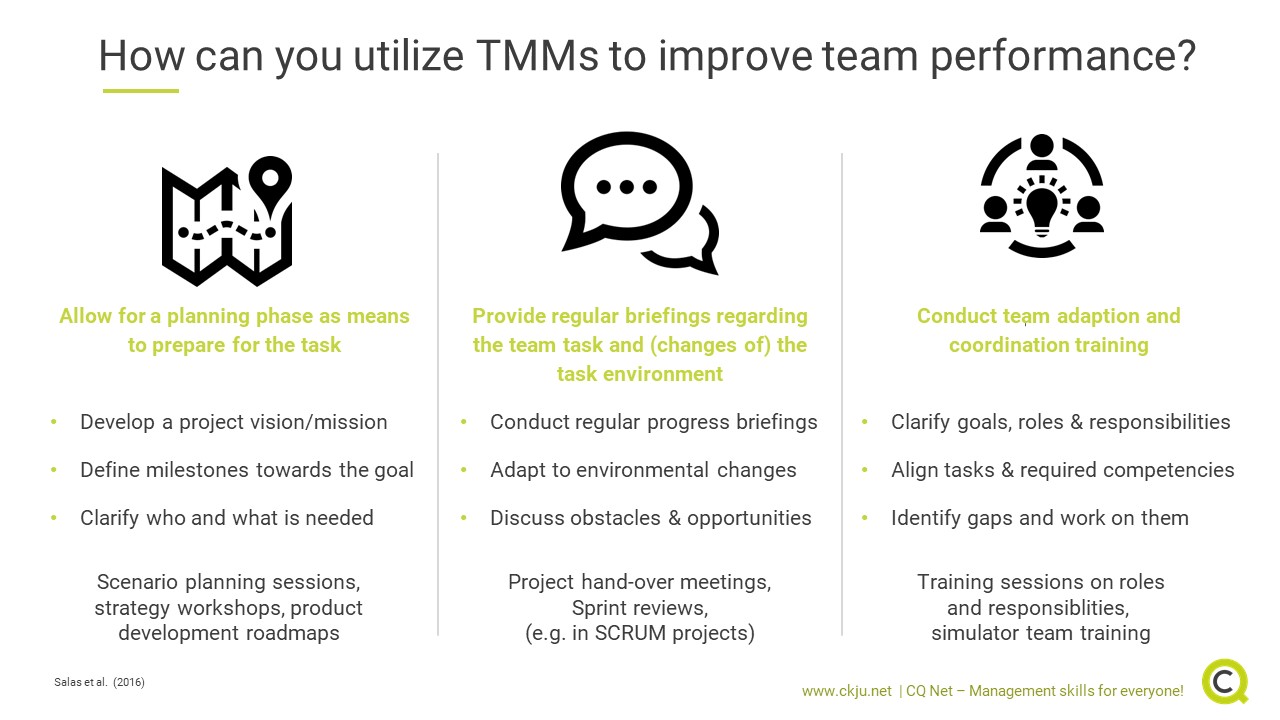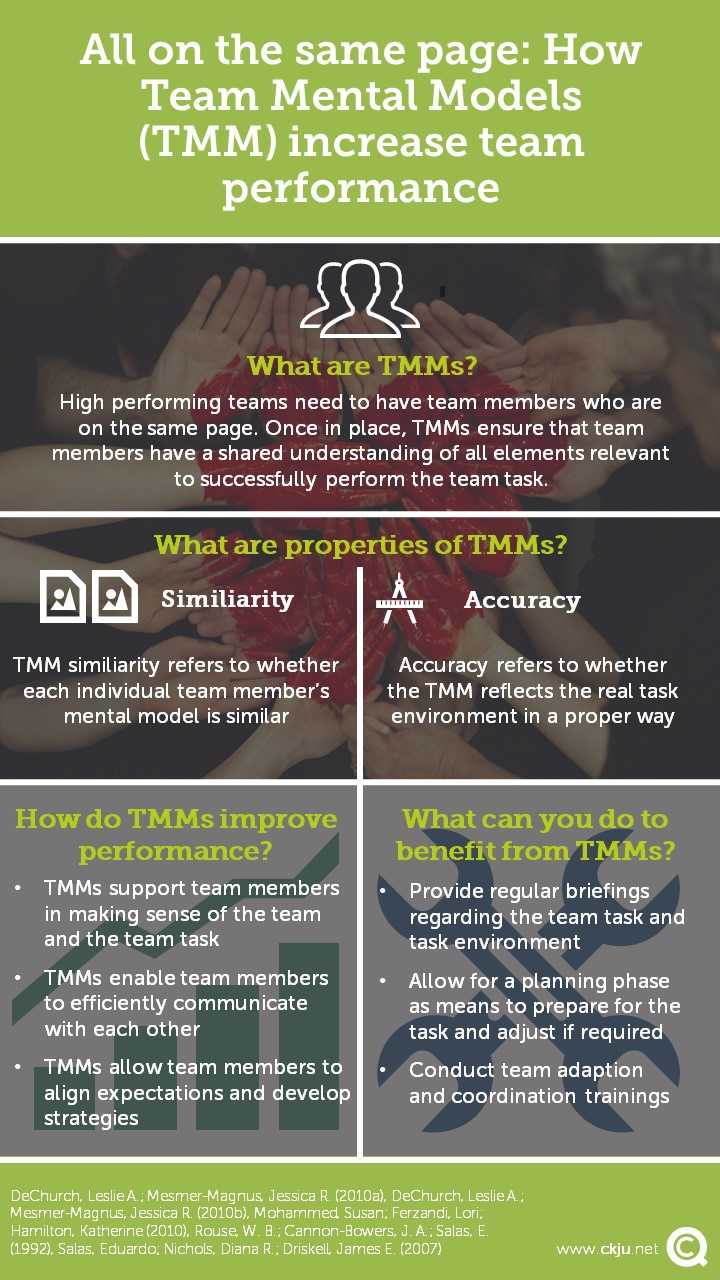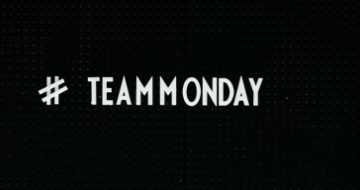- All Management Learning Resources
- Team Mental Models (TMM)

Executive summary
Teams are an important building block of any organization. Measures to improve team performance are a critical success factor for executives, managers and professionals alike. Team Mental Models is a team level phenomenon that derives from team member's cognition and has a positive impact on team performance. This CQ Dossier introduces the Team Mental Model concept, reviews the body of evidence supporting the Team Mental Model - team performance relationhip and provides key take-aways on how you as a management practitioner can utilize TMMs in organizations to improve team performance.
Contents
- Executive summary
- Team performance translates into organizational performance
- Team Mental Models are a means to improve team performance
- What are Team Mental Models?
- What types of Team Mental Models do exist?
- How do Team Mental Models support team efforts?
- Similarity and accuracy are key properties of Team Mental Models (TMMs)
- Do TMMs really increase team performance?
- How can management practitioners utilize TMMs?
- Critical appraisal of Team Mental Models: Solidity Level 5
- Key take-aways
- References and further reading
Team performance translates into organizational performance
You will most properly utilize teams to get complex tasks done in your organization. Areas where you might have teams in place could be product development, production, problem solving, or just for implementing a specific business related project. Many organizations have more than one such business related project running in parallel. Examples include the introduction a new IT-systems, excellence and safety initiatives or projects to introduce new regulatory frameworks. This makes teams an important building block of organization in almost any industry and in the public sector. Whether those teams achieve or even exceed the expected performance criteria adds up to one important component your organization's overall performance.
Team Mental Models are a means to improve team performance
This leads inevitably to the questions what you can do in order to make sure your teams deliver what is expected. There is a strong body of evidence that Team Mental Models have a positive impact on team performance across a wide range of industries and organizational settings. This CQ Dossier targets at summarizing the key take-aways you as an executive, manager and professional need to know in order to benefit from the positive effects of Team Mental Models in your organization.
What are Team Mental Models?
The key theme behind the concept of Team Mental Models is the assumption that high performing teams need to have team members that are “on the same page” in order to perform complex tasks in a dynamic environment (Mohammed et al. 2010). To be on the same page requires team members to have a shared understanding of all elements relevant to successfully perform a specific team task. The origin of a Team Mental Model is thus always the individual team member. However, the Team Mental Model itself is a team level (collective) phenomenon which dynamically constitutes bottom-up from each team member’s cognition (DeChurch and Mesmer-Magnus 2010).
What types of Team Mental Models do exist?
Efforts to distinguish between different types of TMMs has led to differentiation of task related Team Mental Models and team related Team Mental Models (Mohammed et al. 2010). The former reflect a team’s cognitive representation of task related elements such as milestones, goals, resources, technology and interfaces required for task coordination. The later covers the team’s mental model related to the skills, competencies and relationships of individual team members.
Early concepts distinguished an additional third category referred to as equipment related Team Mental Models (Rouse et al. 1992). This third category covers knowledge about tools, technologies and their application. Unfortunately most of the empirical studies we found distinguish only between team and task related Team Mental Models, whereas task-related Team Mental Models covers equipment related knowledge (DeChurch and Mesmer-Magnus 2010b).
How do Team Mental Models support team efforts?
The main functions of Team Mental Models are improved planning, coordination and alignment between team members which materializes in an increased team performance. More specifically, Rouse et al. (1992) defined three main function of Team Mental Models you should take into consideration.
Making sense of the team and the team task (Describe)
First, Team Mental Models support team members in making sense of the team and the team task. They describe why the team exists, how the current state looks like and what has to be achieved in terms of the future state.
Communicate with each other about the team task (Explain)
Second, Team Mental Models enable team members to communicate with each other about the team task and the way the task environment is structured and operates. A common language and a shared understanding of the main mechanisms behind the task environment allows team members to explain what is going on how things relate to each other.
Align expectations and create implementation strategies (Predict)
Third, Team Mental Models allow team members to align expectations and create strategies on how to achieve them. This opens up the possibility to predict what will happen and what has to happen in order to achieve the expected future state.
From a management practitioner’s perspective, all those functions are important success factors for teams working on complex tasks. When you think of a product development project it is key that the whole team has a common understanding of the product features to be developed, the wording used to describe the product features and the stakeholder (customer, product owner, controller etc.) expectations connected to it.
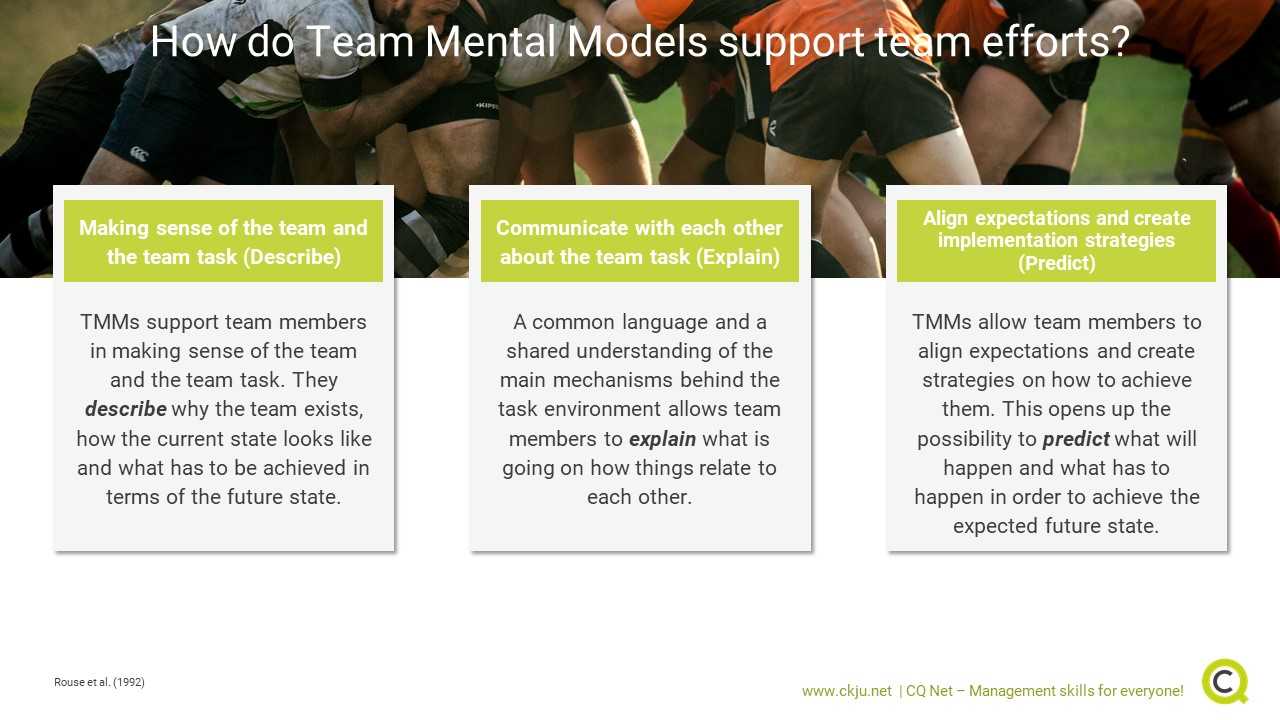
Similarity and accuracy are key properties of Team Mental Models (TMMs)
However, just having a Team Mental Model in place is not sufficient. Finally it is about whether each individual team member’s mental model is similar and whether the Team Mental Model is accurate (Mohammed et al. 2010).
TMM similiarity
You can only benefit from the positive effects of TMMs when your team members share a similar mental model. Think of a pilot and a co-pilot during the take-off procedure. Both can have a mental model of a take-off procedure in mind. However, when the procedures are related to different aircraft types with a different take-off procedure the TMM is not similar which could impair team performance and even put the entire flight at risk.
TMM accuracy
Another important property of TMMs is accuracy. Similar TMMs won’t add value when they are not accurate and thus don’t reflect the real task environment. Consider a cockpit crew with a similar TMM which doesn’t reflect the systems implemented in the specific aircraft type.
Having introduced the concept of TMMs, the question arises what evidence is available that supports the claim that TMMs improve team performance.
Do TMMs really increase team performance?
The concept of TMMs has been around for more than 20 years. As a consequence a vast amount of empirical research is available that addresses the effects of TMMs on team performance. Two recent meta-analysis on the impact of TMMs on team performance indicate a moderate positive relationship (DeChurch and Mesmer-Magnus 2010a, 2010b). This claim is also supported by a recent systematic literature review (Burtscher and Manser 2012) and a review of the TMM theory and research in general (Mohammed et al. 2010).
There is also some evidence available that similarity of task-related TMMs has a slightly stronger positive impact on team performance than task-related TMMs (Mohammed et al. 2010). Interestingly, the elicitation methods (Langan-Fox et al. 2000) used to document the TMM seem to have also an impact on the TMM – team performance relationship. DeChurch and Mesmer-Magnus (2010a) found the strongest relationship when cognitive mapping or content analysis was used.
How can management practitioners utilize TMMs?
Building on the finding that TMMs improve team performance the question arises what you can do to utilize TMMs in your organization. Team training interventions, team briefings and planning can help you to reap the benefits of TMMs. There is some evidence that training interventions that have an emphasis on team coordination and adaption are your first choice to foster TMMs (Salas et al. 2016).
Assumed you want to prepare a team for a market launch of a complex part of machinery, a team training intervention could start with a kick-off workshop where you provide the team an overview of the market launch objective, the technology behind the machinery, the time schedule and critical success factors the team should consider for a successful launch.
In a second step you should give the team the opportunity to ask questions, challenge your assumptions and suggest focus areas for further discussion. Focus areas that emerge from the discussion should be addressed in follow-up discussions which again help the team to establish a TMM of the task and the task environment. There are even some tools in place such as agile frameworks (e.g. SCRUM) and the Crew Resources Management framework that build on TMMs as means to improve team performance.
Critical appraisal of Team Mental Models: Solidity Level 5
More than 20 years of empirical research about the effect of Team Mental Models on team performance is available. This makes Team Mental Models a well-proven and solid management tool to increase team performance. Consequently, the CQ Dossier is assigned a level 5 rating (Based on a 1- 5 measurement scale). A level 5 is the highest rating score for a CQ Dossier based on the evidence provided on the Team Mental Models - team performance relationship.
Key take-aways
- Team Mental Models (TMMs) are a team level phenomenon which derives bottom-up from each team member's cognition
- The main functions of TMMs are improved planning, coordination and alignment
- There is a strong body evidence that TMMs improve team performance
- Similarity and accuracy are key properties of TMMs
- Task related TMMs seem to have a stronger performance link than team related TMMs
- Team training interventions should focus on team adaption and coordination
Management skills newsletter Join our monthly newsletter to receive management tips, tricks and insights directly into your inbox!
References and further reading
Burtscher, Michael J.; Manser, Tanja (2012): Team mental models and their potential to improve teamwork and safety. A review and implications for future research in healthcare. In Safety Science 50 (5), pp. 1344–1354. DOI: 10.1016/j.ssci.2011.12.033.
DeChurch, Leslie A.; Mesmer-Magnus, Jessica R. (2010a): Measuring shared team mental models. A meta-analysis. In Group Dynamics: Theory, Research, and Practice 14 (1), pp. 1–14. DOI: 10.1037/a0017455.
DeChurch, Leslie A.; Mesmer-Magnus, Jessica R. (2010b): The cognitive underpinnings of effective teamwork. A meta-analysis. In The Journal of applied psychology 95 (1), pp. 32–53. DOI: 10.1037/a0017328.
Langan-Fox, J.; Code, S.; Langfield-Smith, K. (2000): Team mental models. Techniques, methods, and analytic approaches. In Human factors 42 (2), pp. 242–271. DOI: 10.1518/001872000779656534.
Mohammed, Susan; Ferzandi, Lori; Hamilton, Katherine (2010): Metaphor No More. A 15-Year Review of the Team Mental Model Construct. In Journal of Management 36 (4), pp. 876–910. DOI: 10.1177/0149206309356804.
Rouse, W. B.; Cannon-Bowers, J. A.; Salas, E. (1992): The role of mental models in team performance in complex systems. In IEEE Trans. Syst., Man, Cybern. 22 (6), pp. 1296–1308. DOI: 10.1109/21.199457.
Salas, Eduardo; Nichols, Diana R.; Driskell, James E. (2007): Testing Three Team Training Strategies in Intact Teams. In Small Group Research 38 (4), pp. 471–488. DOI: 10.1177/1046496407304332.
About the Author


